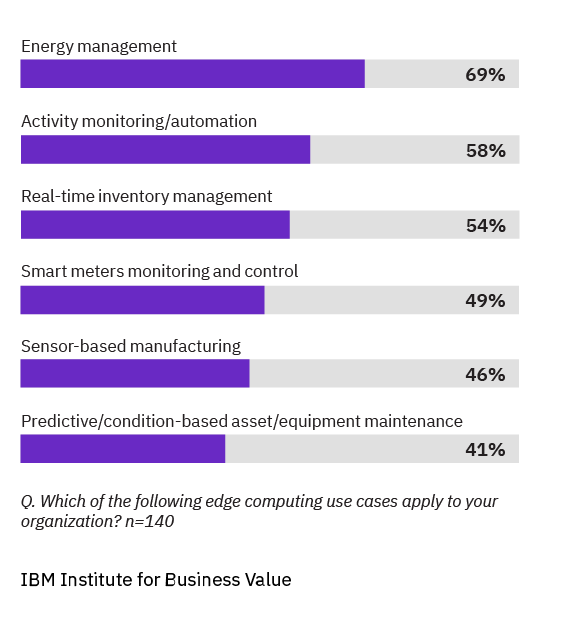The edge computing advantage
Edge, a distributed computing model, brings computation, data storage, and power closer to the source of data generation. Processing data where it is created—at the edge—allows for the more immediate application of analytics and AI capabilities, eliminating round-trip cloud issues and enabling real-time actions. Edge computing can help energy, natural resources, and manufacturing companies take advantage of Industry 4.0 and drive productivity gains.
Smart manufacturing uses intelligence systems to make autonomous decisions that optimize machinery performance and equipment maintenance. The combination of edge computing and Industrial Internet of Things (IIoT) devices leads to smarter supply chains, better equipping them to handle disruption. 5G/private cellular network speed permits factory and remote sensors to provide real-time updates about the operating environment, but it also adds to today’s ever-increasing volume of data with even more connected devices.
Edge Disruptors expect 23% ROI from their edge computing investments within the next 3 years, compared with just 3% for their cohorts.
As devices proliferate, so will data. By 2025, an estimated 38.6 billion connected IoT devices are expected to generate over 90 zettabytes—or 90 trillion gigabytes—of data. Sending this device-generated data to a centralized data center or to the cloud can result in bandwidth, energy, and latency issues.
Edge computing is a more efficient alternative. With edge, much of the data does not travel a network to the cloud or a data center to be processed, significantly reducing latency—the delay in the transfer of data following a transfer instruction. Data can be analyzed at its source, allowing organizations to make decisions and take actions based on the most current data at any point in time. For example, an edge-enabled IoT device can create, process, store, and act on data even when the device is not connected to the internet. When a connection is available, relevant data is then shared within a continuous operating environment.
69% of chemicals, petroleum, and industrial products companies use edge computing for energy management.
Edge computing is on the cusp of explosive growth. With the continued expansion of the IoT, Gartner predicts that 75% of enterprise-generated data will be created and processed outside the traditional data center or cloud by 2025. The number of apps at the edge will increase 800% by 2024, IDC predicts. The edge computing market is also expected to grow at a compound annual growth rate of 34% between 2020 to 2025, with the manufacturing vertical as the largest segment.
The vast potential of edge computing
To understand organizations’ current and future edge computing strategies, the IBM Institute for Business Value, in conjunction with Oxford Economics, surveyed 1,500 executives across 22 industries and 21 countries. This report focuses on the 140 chemicals, petroleum, and industrial products respondents who are aware of and involved in their organizations’ edge computing strategies.
The majority of chemicals, petroleum, and industrial products organizations are in the early stages of edge computing, with over two-thirds in the planning stage. Nearly 3 in 10 are further along in their journey, implementing use cases. In 5 years, emerging technologies will mature, and adoption should advance rapidly, as 94% tell us their organizations will have implemented edge computing by then.
Executives anticipate an average ROI of 6.3% from their edge investments in only 3 years. Organizations expect to achieve benefits from 3 key areas through edge computing solutions: responsiveness, energy efficiency, and business model innovation.
Right on the edge: How chemicals, petroleum, and industrial products companies use edge computing

Read the full report to learn how edge computing is enabling faster, data-driven insights—and why Edge Disruptors are outperforming their peers in revenue growth and profitability.
Meet the authors
Jason Jackson, Chief Technology Officer, Industrial Sector, IBM Global MarketsSpencer Lin, Global Research Leader, Chemicals, Petroleum, and Industrial Products, IBM Institute for Business Value
Marcelo Sávio, Industry 4.0 Architect, Industrial Sector, IBM Consulting
Originally published 06 May 2021






